Evaluation of Analytical Methods for Analysis of Dried Distillers Grains with Solubles

AFIA Sub-Working Group Final Report and Recommendations - February 2007
Within the Fuel Ethanol Industry there are no guidelines or recommendations on which analytical test methods should be used for the measurement of DDGS, which can lead to a significant level of confusion related to analysis and subsequent interpretation of data for moisture, protein, fat, and fiber, all of which are critical feed quality parameters for DDGS. Most wet chemistry methods used for the analysis of DDGS in the analytical community currently are what would be classified as empirical methods, meaning the results are an indirect measurement of the analyte of interest and the results are in part or in whole dependent on the conditions of the assay (i.e. reagent type or concentration and assay parameters like temperature, time, pH, etc.).
Since the analytical community has not yet come to a consensus on what empirical method is best suited for the analysis of any given analyte in DDGS, many different empirical methods are used among laboratories and even within a single laboratory. The use of various empirical methods for a single analyte leads to results that vary significantly from lab to lab and thereby can create confusion for producers, marketers, nutritionists, regulatory bodies, and most importantly the customers/end-users. Segal’s Law, which states, “A man with a watch knows what time it is. A man with two watches is never sure”, sums up the current state of affairs best as it relates to analysis of DDGS.
This problem was identified by the ethanol industry and strategically addressed in the Fall of 2005; two working group bodies were formed to collectively address the problem and cooperatively design a study which would lead to recommendations on the most applicable test methods for DDGS. The two bodies formed to accomplish this task were:
| RFA Testing Subcommittee (Operating under the RFA Co-Products Committee) Members: | ||
| Shon Van Hulzen | Broin Management | |
| Dr. Lance Forster | ADM | |
| Charlie Staff | Distillers Grain Technology Council | |
| Bob Dinneen | Renewable Fuel Association |
| AFIA DDGS Analytical Methods Sub-Working Group (Operating under the AFIA DDGS Technical Issues Working Group) Members: | ||
| Shon Van Hulzen | Broin Management | |
| Dr. Lance Forster | ADM | |
| Charlie Staff | Distillers Grain Technology Council | |
| Dr. Thomas Robb | Abengoa Bioenergy | |
| Dr. Phil Smith | Tyson Foods, Inc. | |
| Thomas Sliffe | Perten Instruments | |
| Trace Yates | Tyson Foods | |
| Mark Host | FOSS North America | |
| Lars Reimann | Eurofins Scientific |
Shon Van Hulzen, Quality Control Director, Broin Management, was chosen as the chair for both committees. Nancy Thiex, Laboratory Manager, Olson Biochemistry Laboratories, South Dakota State University and chair of the Association of American Feed Control Officials (AAFCO) was selected as the primary consultant by the AFIA group, and was the organizer, coordinator, and statistical evaluator of the study.
The RFA group was to provide input and insights from the perspective of the ethanol industry as well as provide several members to serve on the AFIA group, which also included several representatives from the feed industry as well as other stake holders. The AFIA DDGS Analytical Methods Sub-Working Group was also the body responsible for setting the direction of the study, see to its completion, and reporting the final outcome and eventual recommendations based on the data.
The Study
The study was designed to evaluate the efficacy, applicability, the intra- laboratory variation, and the inter- laboratory variation of the most commonly used test methods in the analytical community for the analysis of Moisture/Loss on Drying, Crude Protein, Crude Fat, and Crude Fiber. Table 1 below lists the analytical methods that were evaluated in this study.
Table 1 Test Methods for DDGS with Test Method Reference by Organization

Phase I, which was designed to evaluate the efficacy, applicability, and the intra- laboratory variation of the respective test methods, involved the analysis of 30 samples, which were collected from six carefully selected locations (five samples from each location) with the intent of gathering a sample set that resembles a cross section of the market. The six locations are found in Table 2 below.
Table 2 Phase I Sample Matrix Locations
| 2 locations from Broin Companies Corn Dry Mill Plants - (2 different processes) 2 locations from ADM Corn Dry Mill Plants - (2 different processes) 1 location from an Alternative Feedstock Dry Mill (Western Plains Energy in Oakley, KS) 1 location from a Beverage (potable) Plant (Jim Beam) |
Each of the 30 samples (5 samples from each location X 6 sample locations) was analyzed in triplicate by all of the methods listed in Table 1 above at the Olsen Biochemistry Laboratories, under the direction of Nancy Thiex. The results achieved are summarized in Table 3 below and in Figures 1-2 below.
Phase II, which was designed to evaluate the inter- laboratory variation, involved the analysis of 5 samples, which were a subset of the samples collected for Phase I. The five samples were one sample from each of the six locations – one of the locations was unable to submit the larger sample size required for the inter laboratory portion of the study and was thereby left out of Phase II, hence the five samples in Phase II instead of the intended six samples. The five samples were sent to 23 participating laboratories and analyzed in duplicate for each method the respective laboratory had signed up for in advance. The results achieved for the five samples at the 23 participating laboratories are summarized in Table 3 below and in Figures 3-4 below.
Conclusions
All statements in the following sections are based on the statistical analysis and related conclusions found in the final report from Nancy Thiex, which can be supplied upon request by contacting either Nancy Thiex or Shon Van Hulzen. A summary of the committee’s recommendations can be found in Table 4 below.
Moisture/Loss on Drying
Although it is commonly known and widely accepted that Karl Fischer Titration provides the most accurate measurement of water in feed, the labor (both time and training), reagent, and instrument costs make Karl Fischer analysis an economic burden that most laboratories would not be willing to bear. The committee recognizes these concerns and has used Karl Fischer as the means of determining the gravimetric (loss on drying) method that has the least amount of bias when compared to actual Karl Fischer method. Using this criteria, NFTA 2.2.2.5, Lab Dry Matter (105 ºC / 3 hr), was selected as the recommended method for the analysis of moisture in DDGS; this method also had acceptable CV’s (coefficient of variation—a method of determining repeatability) in both the intra- and inter- laboratory portions of the study.
The committee also wishes to emphatically note that all gravimetric methods be considered, and used accordingly, as “loss on drying” methods and only serve as an estimation of the “true” moisture level. One of the gravimetric methods, AOAC 930.15, Loss on Drying (Moisture) for Feeds (135 ºC / 2 hr), was shown to dramatically overestimate the moisture content in DDGS and therefore, it is highly discouraged to use this method to analyze samples of DDGS; use of this method is widespread as demonstrated by the fact that 17 of the 23 labs reported values using AOAC930.15.
Crude Protein
The protein methods investigated in this study were determined to be statistically equivalent, and both had acceptable coefficients of variation for both the intra- and inter- laboratory portions of the study. AOAC 990.03, Protein (Crude) in Animal Feed – Combustion, and AOAC 2001.11, Protein (Crude) in Animal Feed and Pet Food (Copper Catalyst), can therefore be used interchangeably to provide accurate and precise protein results on DDGS.
Crude Fat
The three non-hydrolysis fat methods (AOAC 2003.05, AOAC 945.16, and AOAC 2003.06) were determined to be statistically equivalent methods for the analysis of DDGS, however, in the inter laboratory portion of the study, AOAC 945.16, Oil in Cereal Adjuncts (Petroleum Ether), had a significantly lower coefficient of variation than the other non-hydrolysis methods and has thereby proven to be a more robust method in the analytical community, and is therefore chosen as the recommended test method for the analysis of fat in DDGS.
The acid hydrolysis method (AOAC 954.02) was determined to be significantly different, with a bias of ~+4% (absolute difference). It should be noted that only relative accuracy was compared and since all four methods in the investigation are empirical in nature, further work would need to be completed to determine the most accurate method. However, since the three non-hydrolysis methods were found to be statistically equivalent methods, it was decided that the most robust (most repeatable) non-hydrolysis method in the inter- laboratory portion of the study would be selected as the method of choice.
Crude Fiber
Both crude fiber methods evaluated, AOAC 978.10 and AOCS Ba 6a-05, were considered to be not significantly different. However, the “F58 Filter Bag”, which is needed to comply with AOCS Ba 6a-05 is no longer commercially available. The recommended replacement, the “F57 Filter Bag”, which is commercially available has been shown to cause a 10% (relative) low bias. It is doubtful that AOAC 978.10 and AOCS Ba 6a-05, modified for the F57 bag, would be statistically equivalent. Based on lack of availability of the F58 filter bag which is needed to perform AOCS Ba 6a-05, the committee is recommending AOAC 978.10, Fiber (Crude) in Animal Feed and Pet Food (F.G. Crucible), as the recommended method for crude fiber analysis on DDGS.
| Table 3 Summary of Results |
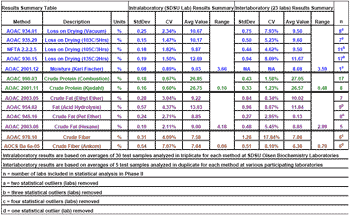 |
| To enlarge the image, click here. |
| Figure 1 |
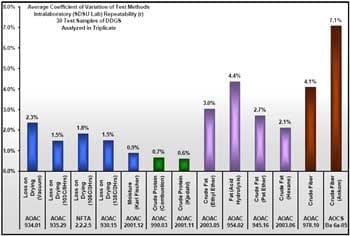 |
| To enlarge the image, click here. |
| Figure 2 |
 |
| To enlarge the image, click here. |
| Figure 3 |
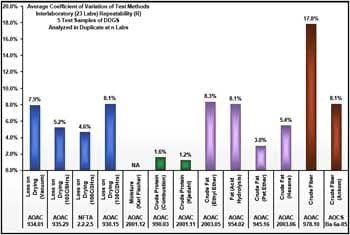 |
| To enlarge the image, click here. |
| Figure 4 |
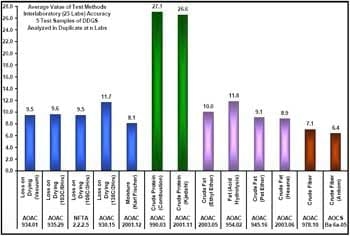 |
| To enlarge the image, click here. |
| Table 4 AFIA DDGS Analytical Method Recommendations |
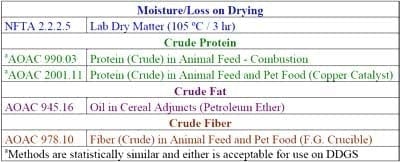 |
AFIA DDG/S Technical Issues Working Group - DDG/S Definitions Sub-Working Group
Summary Report and Recommendations
Abstract
The group addressed two questions: (1) whether the AAFCO legal definition should be amended; and (2) how the AFIA guidelines should be updated.
The answer to (1) was “no.” It was generally felt that changes in the AAFCO definitions would tend to limit trade without providing any further clarity between supplier and customer.
The answer to (2) was that the AFIA Ingredient Guidelines should be updated to address modern processing technologies. Draft changes are attached as appendices.
Appendices
1. Draft – Proposed AFIA Guideline Updates: DDG/S
2. Draft – Proposed AFIA Guideline Updates: CCDS
Background
There is an explosive growth in the amount and type of Distillers Products becoming available on a wide-spread basis. As with any growth industry, there is some confusion surrounding the technical issues of DDG/S – specifically, issues impacting trade. Over the past several months – in various venues – several different solutions have been proposed to help reduce this confusion.
The AFIA has taken a leadership role in addressing the most important of these issues. A meeting of the AFIA DDG/S Technical Issues Working Group was convened in Kansas City in 2005. Two specific items were selected for further work: “Analytical Methodologies” and “Definitions.” Two sub-working groups were formed.
The “Analytical Methodologies” issue is, by far, the most pressing matter to be addressed. That group has made tremendous strides in addressing this issue. Those efforts are reported elsewhere.
The “Definitions” issue is much less pressing. However, at the prompting of the Working Group, a Sub-Working group was convened to revisit this issue from a new perspective. Specifically, four individuals representing DDG/S producers and four individuals representing buyers were appointed to the group. The group was charged with two issues: (1) whether the AAFCO legal definition should be amended; and (2) how the AFIA ingredient guidelines should be updated.
Findings of the sub-working group follow.
Findings of the Sub-Working Group
Should AAFCO Definitions Be Amended?
Bottom Line: No.
The group felt that the AAFCO Definition(s) adequately define(s) the Distillers Product(s) of today. Further changes might impact new technologies. A broad definition was preferred which are the current definitions.
No further action required.
How Should AFIA Ingredient Guidelines Be Updated?
General Feedback: It was generally agreed that some updates should be considered. Actually, after reviewing the current AFIA Ingredient Guidelines, it seemed that the participants had a greater understanding of DDG/S (and CCDS), in general.
Several items were presented for discussion. All were considered as viable suggestions.
An action item was taken: submit all ideas for review and summary.
Three participants (4, including the chair) responded with written items for inclusion in a proposed update. Charlie Staff, Distillers Grains Technology Council, submitted the two AFIA Guidelines with proposed modifications included. These served as basis for including suggestions from all participants. These draft proposed AFIA ingredient guideline updates are attached to this report (See Appendices).
Specific Topics: The main points of the discussion and subsequent submissions focused on:
( 1) ethanol process (Fuel vs. Potable vs. Other Grades),
(2) typical nutrient analysis (and some discussion about exceptions),
(3) physical characteristics, and
(4) a general notice that specifications should be a contractual issue.
Further Action Items
Suggestion: After an appropriate period of time, this Sub-Working Group should reconvene to consider any and all suggestions to the draft ingredient guideline updates; a final version of each product Guideline can be proposed to AFIA for adoption.
The chair notes he edited the two guidelines developed more than 20 years ago. These edits are in addition to the ones submitted by sub-working group members.
Some personal observations from the Chair:
1. AFIA Guidelines: The AFIA Guidelines should be updated. The role of the AFIA in providing these guidelines – and overall leadership in this area – cannot be over-emphasized. The proposed Guidelines may require some further work before they become final. Other Distillers Products Guidelines may need to be re-evaluated. This may be an exercise that should be routinely done for many ingredients.
2. Actually, the process of reviewing the current AFIA Guidelines and suggesting updates seemed to be pretty educational per se. There may be a “take-home” message that education about the current products is probably more important than new documentation.
3. AAFCO Definitions: The decision to not change the AAFCO Definitions seems more appropriate today that ever before.
For the Sub-Working Group:
Matthew L. Gibson, Ph.D.
Chair, Definitions Sub-Working Group
VP, Tech Svcs & Mktng
Dakota Gold Marketing
DISTILLERS DRIED GRAINS WITH SOLUBLES (27.6)
PRODUCT DESCRIPTION:
Distillers dried grains with Solubles (DDG/S) is a product obtained by condensing and drying the whole stillage remaining after the removal of ethanol by distillation from the yeast fermentation of grain or grain mixture by condensing and drying at least three-fourths of the solids of the resultant whole stillage by methods employed in the grain distilling industry. The whole stillage contains coarse material that is separated from the thin, watery portion by centrifuging or screening. The thin stillage fraction is concentrated by evaporation to a syrup (Condensed Distillers Solubles – CDS) and then added back to the coarse fraction and dried in rotary, flash, or steam-tube heated air dryers. The predominating grain must be declared as a first word in the name; i.e. Corn Distillers Dried Grains with Solubles (CDDG/S).
This product is made from a dry milling operation which makes potable, fuel, and / or other grades of ethanol.
TYPICAL ANALYSIS:
| Moisture, % | 8 - 12 | Protein, % | 25 - 28 | |
| Ether Extract, % | 6 - 10 | Crude Fiber, % | 8 - 10 | |
| Ash, % | 4 - 5 |
Specifications should be determined by buyer and/or seller at the time of sale.
FACTORS INFLUENCING QUALITY:
The nutritional composition of corn distillers dried grains with solubles will typically be uniform if acquired from the same production facility – regardless of whether the grain is processed for fuel or beverage (potable) use. However, there may be considerable variation in product acquired from different ethanol production facilities.
For the majority of the distilleries, the composition of distillers grains with solubles is approximately three times that of the cereal grains used (plus vitamins and yeast cells and metabolites produced during fermentation). Higher drying temperatures, mash bill differences, and residual sugars can influence the degree of color and / or darkness.
STORAGE AND HANDLING:
Corn distillers dried grains with solubles with uniform moisture (8-12%), properly cooled and stored in an enclosed cool location, will withstand long periods of storage. Occasionally if the corn distillers dried grains is not cooled sufficiently at the distillery after drying, or allowed to store 24 hours before shipping, there may be increased problems during transportation due to reduced flowability.
PHYSICAL PROPERTIES:
| Color: | Yellow to Brown |
| Odor: | Sweet and Cool; Not Burnt or Musty |
| Bulk Density: | Approximately 30 – 35 lb per cubic foot |
| Texture: | Can range from fine/powdery to coarse/gritty |
| Depending upon the original fineness of grind of the grain |
AVAILABILITY:
Corn distillers dried grains with solubles is now readily available in all areas of the United States; principally in Midwest by truck and rail and by rail at the West and East coasts of the United States. Export markets are served by railcars into northern Mexico and barge and export container quantities moving to export overseas markets.
MAJOR FEED APPLICATIONS:
Corn distillers dried grains with solubles have been readily incorporated into many rations for ruminants and non-ruminants, alike. It is an excellent source of energy, protein, fat, phosphorus, and bypass protein. It has been widely accepted as an excellent ingredient for dairy, beef cattle and is gaining acceptance in swine and poultry rations.
DEFINITIONS AND NAMES:
AAFCO Ingredient Definition – #27.6. Please note: the predominating grain shall be declared as a first word in the name. IFN#5-12-185 Barley distillers grains with solubles; IFN#5-07-987 Cereals distillers grains with solubles; IFN#5-02-843 Maize (corn) distillers grains with solubles; IFN#5-04-024 Rye distillers grains with solubles; IFN#5-04-375 Sorghum distillers grains with solubles; IFN#5-05-194 Wheat distillers grains with solubles.
RELATED “NEW PROCESS” PRODUCTS:
Some distilleries are removing the corn germ and/or the corn bran prior to fermentation which substantially reduces fat and/or crude fiber content of the final product. Some distilleries are removing the fat before or after condensing of the syrup which also reduces substantially the fat content of the finished CDDGS product. In both of these processes, the fat content is decreased and protein content increased. Some of these higher protein products are called high protein corn distillers dried grains (DDG; protein content 33 – 45 %).
CONDENSED DISTILLERS SOLUBLES (27.7)
PRODUCT DESCRIPTION:
Condensed distillers solubles (CDS) is obtained after removal of ethanol by distillation from the yeast fermentation of a grain or grain mixture by condensing the thin stillage fraction to a thick viscous liquid. The predominating grain must be declared as a first word in the name; i.e. corn condensed distillers solubles (CCDS).
This product is made from a dry milling operation which makes potable, fuel, and/or other grades of ethanol.
TYPICAL ANALYSIS:
| Dry Matter, % | 28 - 45 | Protein, % | 7 - 15 | |
| Ether Extract, % | 4 - 20 | Crude Fiber, % | 1 - 5 |
Specifications should be determined by buyer and/or seller at the time of sale.
FACTORS INFLUENCING QUALITY:
The nutritional composition of condensed distillers solubles will typically be uniform if acquired from the same production facility – regardless of whether the grain is processed for fuel or beverage (potable) use. However, there may be considerable variation in product acquired from different ethanol production facilities.
Different processing may significantly alter composition. Processes which will result in lower fat content (and correspondingly higher protein content) may include: (1) removing the germ fraction prior to fermentation, (2) removing corn oil before or during evaporation, and (3) using screens for separating whole stillage rather than centrifuges.
Condensed distillers solubles viscosity is dependant upon solids content and temperature and is usually similar to other concentrated liquid feed ingredients, i.e. molasses, condensed steep water, etc. Ordinary mild steel tanks, pipes, pumps and fixtures are satisfactory for a normal length of storage, agitation is highly recommended. The product is normally delivered by railcars or tank trucks. Heat or extended storage may result in darkening color and thicker viscosity products.
PHYSICAL PROPERTIES:
| Color: | Yellow to tan colored liquid with syrup consistency |
| Bulk Density: | Weight per gallon: 9.4 – 10.0 lb. |
| pH: | 4 – 4.5 |
| Viscosity: | Increases with decreasing temperatures |
MAJOR FEED APPLICATIONS:
Condensed distillers solubles have been used extensively by liquid animal feed manufacturers for many years because of its nutritional value and palatability. In past years, dried CCDS was found to be an excellent feed ingredient for non-ruminant rations.
DEFINITIONS AND NAMES:
AAFCO Feed Ingredient Definition # 27.7. Please note: the predominating grain shall be declared as a first word in the name. IFN#5-12-211 Maize (corn); Barley IFN#5-12-210; Cereals IFN#5-02-146; Rye IFN#5-12-212; Sorghum IFN#5-12-231; Wheat IFN#5-12-213.
ADDITIONAL INFORMATION:
The production of fuel and beverage ethanol is accomplished by cooking a milled-grain mash and adding an enzyme to convert the starch to fermentable sugars. Yeast is then added to cause fermentation and conversion of the sugars to alcohol and carbon dioxide. The fermented mash is called distillers beer and is passed through a distillation column to extract the alcohol. Residual liquid from the distillation column is called whole stillage and contains all the vitamins, minerals, fats and proteins of the whole grain which are concentrated by removal of the starch. After distillation, the whole stillage is separated into soluble (thin stillage) and insoluble fractions by screening or centrifuging. With screening, the majority of the fat remains with the insoluble portion and with centrifuging the majority of the fat is carried into the soluble fraction prior to evaporation. If the germ of the grain has been removed prior to fermentation, the fat content of the CDS will be substantially reduced (30-70%). Evaporators concentrate the thin stillage to a 25-45% solids content, and it is the condensed distillers solubles product that result. It is an excellent feedstuffs due to its soluble amino acids, proteins and valuable nutrients.
Our greatest acknowledgement to AFIA (American Feed Industry Association); RFA (Renewable Fuels Association); and NCGA (National Corn Growers Association) for the kind contribution and the permission to reproduce this report.









